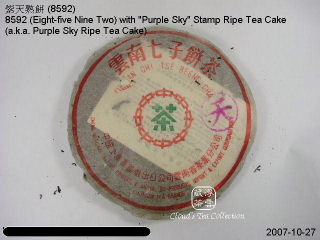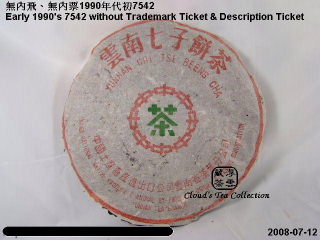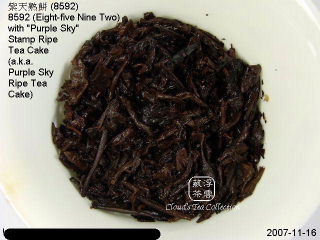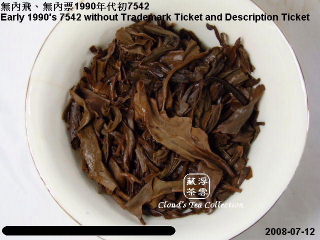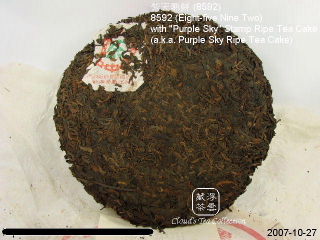
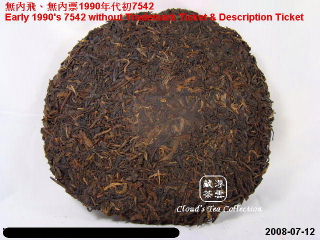
In the last Cloud's Tea Diary, the tea broth and aftertaste of the aged ripe tea (The Purple Ripe Tea Cake) were discussed. Cloud will further reply the remaining questions raised by a tea lover, who asked, "What are the differences between the aged raw tea cakes and the aged ripe tea cakes? What are the good aspects of both kinds of tea? Why is the aged raw Puerh so expensive?"
Cloud is of the view that in order to understand the differences, there must be personal appreciation experiences of both the aged raw tea cakes and the aged ripe tea cakes. Thus, Cloud chose the raw and the ripe tea cakes from the early 1990's for comparison. In relation to the tea cakes from the early 1990's, Cloud has already written three diaries:-
- 2008-07-12 Early 1990's 7542 After A Banquet (Re: Aged Raw Puerh)
- 2008-10-25 Early 1990's 7542 with TT & DT (Re: Aged Raw Puerh)
- 2008-11-09 The Early 1990's Purple Sky Ripe Tea Cake - 8592 (Re: Aged Ripe Puerh)
What are the differences between the aged raw tea cakes and the aged ripe tea cakes?
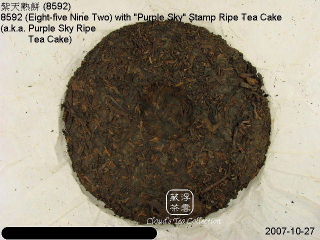
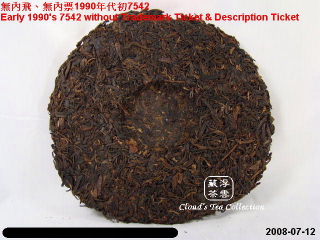 Obviously, the major difference between the aged raw Puerh and the aged ripe Puerh is their flavor.
Obviously, the major difference between the aged raw Puerh and the aged ripe Puerh is their flavor.
The aged raw Puerh tea after decades of aging (as long as it has been aged under proper aging conditions such as dry storage or mild wet storage), the tea broth will offer a fresh, vivid, sweet aftertaste with gradation of sensations. Besides, the aged raw Puerh tea will also bring you an expectation that it will certainly age in the next few decades. When a tea lover chips off a little piece from the same raw tea cake every several years and brews it, he/she will be happy and astonished by the improving aging tastes with the aged aroma and tea broth, which are both gradually increasing with time.
On the other hand, the purpose of inventing ripe tea was to supply artificially fermented tea for instant consumption within a short period of time without the long natural aging process, so to speak, "people can consume the ripe tea once it is manufactured". Therefore, we can surely say that the taste of ripe Puerh is actually fixed at the very beginning. Certainly, ripe Puerh with appropriate degree of fermentation will taste great initially. Theoretically, there is no need for further storage to expect an improvement because ripe Puerh was designed as a "short-term" substitution for aged raw Puerh tea (in terms of "short-term" referring here, it means 5 to 10 years when comparing with the normal aging years of raw tea which may take 30 to 40 years).
Some may argue that there is still some little room for ripe Puerh's improvement. That is possible. Cloud is of the view that the improvement may come from the gradually vanishing unpleasant fermented smell remaining on the tea cake after the process of artificial fermentation or from the aging ability of the unfermented raw part which should be treated as an incomplete fermentation. In other words, if the artificial fermentation is 100%, Cloud believes that there is not much room for further aging (except one case that one may still feel improvement from the 100% fermented ripe tea because the better feeling comes after the unpleasant fermented smell (the earthy taste) has vanished).
Although after more than a decade's aging time (no matter under what storage conditions), fermented ripe Puerh is still ripe Puerh even though it changes from a young ripe Puerh to an aged ripe Puerh. The tea broth of aged ripe Puerh is more or less mellower and sweeter. However, it is still lack of vividness and incredible aftertaste normally offered by aged raw Puerh. Therefore, tea lovers will discover that there will be no obvious changes of the ripe Puerh flavor even though the ripe tea has been stored for several years or a decade. That's why Cloud always advises novices, "If you have already prepared for storing Puerh tea in the next 20 years, it'd be better for you to store mainly on raw Puerh because 20 years or above raw tea will normally offer a great aftertaste with a truly tasty and vivid tea broth."
What are the good aspects of both kinds of tea?
It is a realistic question. That is the balance between the Quality and Price. Who doesn't admit that the 1950's Red Mark is fantastic and awesome! However, it is outrageously expensive for a single brew (US$500 per brew or US$15,000 per tea cake in 2009).Generally speaking, the advantages of aged raw Puerh are its freshness, vividness, sweet aftertaste with gradation of sensations. Unfortunately, the drawback of aged raw Puerh is its high selling price (unless you store the tea cakes yourself at the very beginning).
On the contrary, owing to the fact that aged ripe Puerh is lacking of vividness and incredible aftertaste normally offered by aged raw Puerh although aged ripe Puerh still has mellower and sweeter tea broth, the selling price of aged ripe Puerh can just be a half price of the aged raw Puerh from the same year of production. The cost of appreciation is much lower.
Why is the aged raw Puerh so expensive?
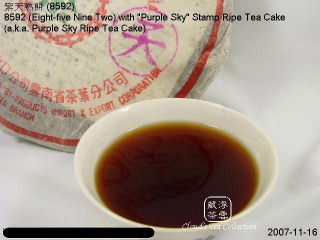
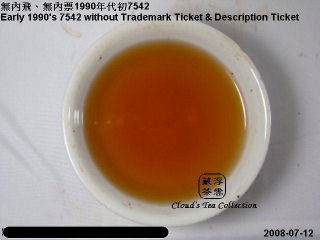
Then, tea lovers will understand the reason why the selling price of aged raw Puerh is so expensive. It is because ripe Puerh (no matter it is young or aged) cannot offer the same quality of the aged raw Puerh. The great and gorgeous aged raw tea broth can only be obtained naturally by proper storage through at least 20 years of aging time under the conditions that "the tea leaves are good, the production process is good and the storage is good".
Honestly speaking, even though the newly made young raw tea cakes (say, 1 year) were incredibly cheap at the very beginning, tea lovers will not sell them easily after 20 years of aging unless the price is high enough. The reason is simple. The value of the tea cakes after 20 years is not the same value when it was produced. The value reflects the 20 years storage time and careful hoarding. As long as the tea cakes offer great tastes after 20 years, the owner will not sell them to the public market easily (unless the offering price is very very high). Therefore, Chinese says, "Puerh tea is a drinkable antique." To a certain extent, it is correct.
16 November 2008 wrote in Chinese
21 May 2009 translated into English
Cloud (Hong Kong)
Back to: By Category reading mode
Cloud's Tea Diary
http://www.cloudsteacollection.com/html/weblog/weblog_e.html
Cloud's Tea Collection - Private Tea Album
http://www.cloudsteacollection.com
